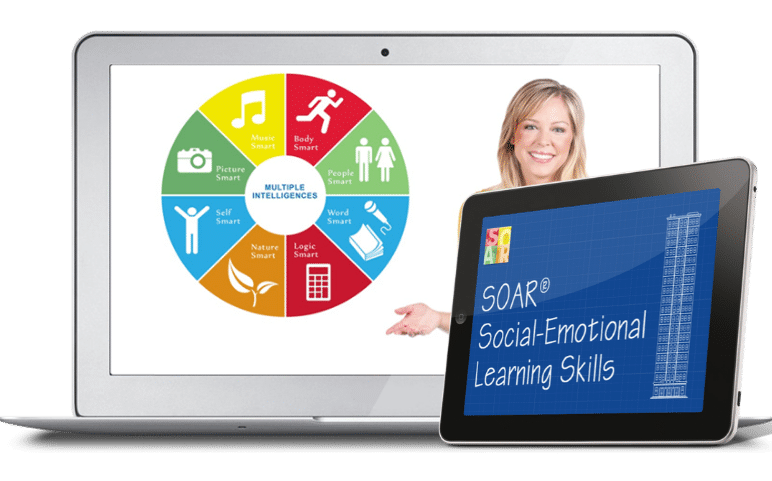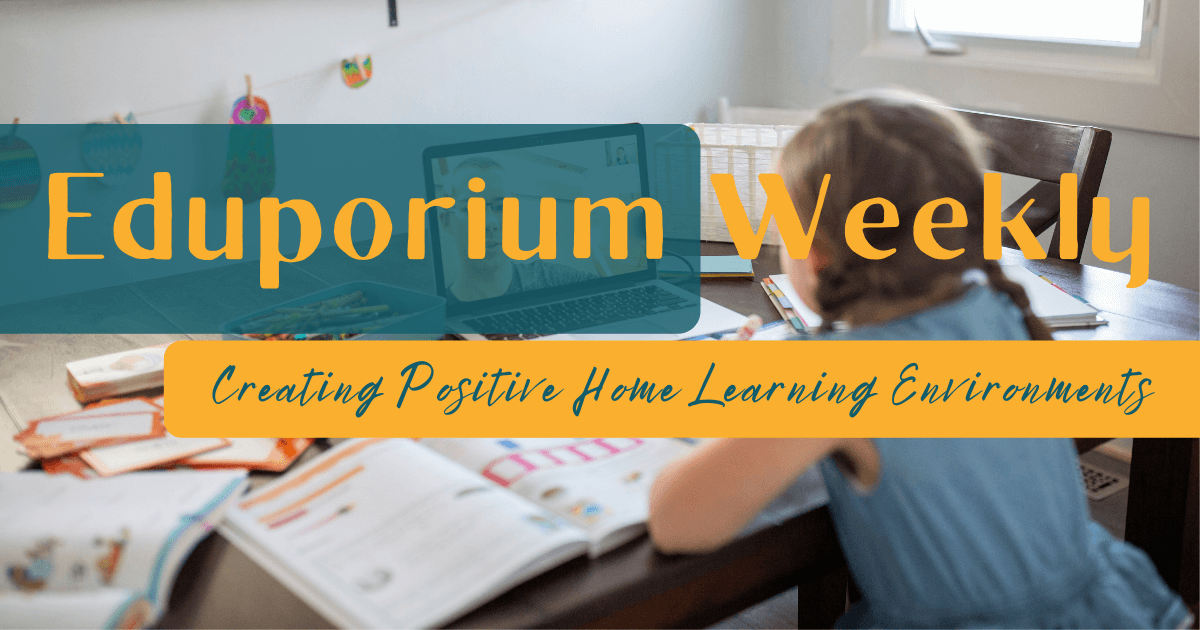Much has been made (and rightfully so) about the importance of integrating social-emotional learning in today’s instruction. Whether kids are still learning from home or they're back in classrooms, so much focus remains on overall social-emotional health. We have also talked extensively about SEL in remote learning, focusing mostly on checking in on students and teachers. Another component to social-emotional learning these days involves creating the right environment for children to reconnect with the things they have been missing throughout the pandemic. This is easier said than done for all those students who are still learning remotely. With the right mindset and approach, however, teachers and parents can create positive learning experiences as kids attend school virtually.
Creating an Optimal Home Learning Environment
For some kids, the ways in which their learning environment is designed does not impact them emotionally or academically. For others, however, it can have a huge effect on their achievements and also lack thereof. Learning environments often contribute to making children feel comfortable and intentional attempts at this can prove to be very helpful. Different students need different kinds of support from their parents, teachers, and even their learning environment. Some may be fine regardless of where they are or what they have, but others may get easily distracted, become discouraged, or feel increasingly isolated from classmates. These days, home learning environments involve various elements, most notably the environment teachers create in live lessons. But, there's also the one that results as kids do independent work for the rest of the day.
Creating those environments has fallen completely on parents, although they could benefit from input from teachers or other parents. The two big factors that parents should consider when creating a positive home learning environment are the age of the child (kids of different ages need different things) and their personal interests. A young student, for example, will likely require a literacy-rich environment that is also conducive to play-based learning. A place for structured play and opportunities to utilize their imaginations through inventive and active play could also be beneficial when they are not in front of the computer screen. Also, creating room for the child’s interests can be very important. Incorporating those interests can go a long way in sparking excitement and creating connections between things they enjoy and learning.
So, how can parents create these environments? They can designate an area specifically for learning. This shows kids that learning is important enough to have its own space with no clutter, a strong source of light, low noise, no distractions, and even a comfortable temperature. The spaces in which students receive their instruction and do their work should also be as accessible as possible. This means it's best for your kids to have access to all the items (computer, pencil, paper, etc.) that they need without needing to ask for help to reach them or opening things. Personalizing every child's learning spaces could also be helpful and having them do different tasks or focus on different subjects in unique places also helps. Plus, getting kids in clear routines can help parents transform the home learning environment into something that’s advantageous.

Many Parents Are Now Teachers: How to Help Kids
If we’re being realistic, the struggles of remote or hybrid learning are falling on parents too, though maybe not to the same extent as teachers. It’s still very new to parents and, as protocols evolve, they're doing all they can on the fly to help. The thing for parents, however, is that most o them don’t have a background in education or training on getting children to sit still and learn like all teachers do. No one expects parents to quickly get an education degree, but there are some tips to help things run smoothly. One thing to keep in mind is children are always ready to learn, but you must understand how they learn. All questions kids ask or objects they touch is an attempt to learn and adults can turn this to growth.
Children are naturally curious and educators can certainly harness this in many home learning experiences. Parents should be willing to use those questions kids ask to extend their learning or introduce them to new ideas. Focusing on and learning more about their interests can also help parents create more personalized learning experiences for kids. Some toys are great at fostering curiosity and creativity and there's plenty of STEAM toys you can use at home. Another thing for parents to remember is that children have this natural interest in the environment. Allowing them to interact with the environment, including with other kids when it’s safe, is one of the best ways to use their desire to explore for good. Through these active explorations, children will start to learn more academic and social-emotional skills.
When it comes to their remote learning, many children are learning independently for a lot of the day. Class periods and face-to-face meeting times with teachers are much shorter than they would be in the physical classroom. Students spend a lot of time doing homework and other assignments to show what they know and parents can use this as a chance to help their kids communicate their ideas in different ways whether it is through speech, writing, or other hands-on projects. This gives them opportunities to be creative and shows kids how they could communicate and appreciate different forms of media. Finally, parents should remember that all kids learn differently and this could definitely be true within the same household. Trying different methods to help engage them could be important until finding the right method for each kid.
Parents as Supporters and Advocates
A lot of times when we're talking about positivity in education, we’re referencing social-emotional health of students (and even teachers). That's not the only piece of the equation, however, and positivity can impact the way students learn on multiple levels. Short of creating their lesson plans and delivering the instruction themselves, so much has fallen onto these parents of children who are learning remotely all or some of the time. Plans are sometimes changing too, leading to greater stresses and uncertainties for the adults in the lives of some students. This uncertainty has also led to parents trying to figure out how to best embrace all of the unknowns and see each new element as opportunities to try something new. That’s easier said than done, however, and a parent’s stress and negativity can affect learning environments for students at home.
Besides helping to create a supportive environment for students at home, many parents (especially of older students) are finding that they’re toeing the line of becoming too involved in their child’s schooling. Balance is, of course, important especially since children typically get to do their own exploration and discover what it is they are most interested in when learning in the traditional classroom. A typical classroom environment can catalyze curiosity and that's often tough to replicate with kids at home all the time. Even something as simple as feeling like parents are hovering could affect how students engage with teachers and classmates remotely. They could wind up feeling pressure in a different way or revert to acting in the way they typically do around their parents as opposed to how they act in the classroom. So, it might be beneficial for parents to be in another room during live lessons.
Parents in this situation could learn a lot the more they communicate, including with their kids to learn their preferences and also with other parents to potentially find various new insights and ideas. Getting students comfortable with expressing their opinions and asking questions can help them now and in other situations as well. On the other hand, parents can also be advocates for equity and voice any equity concerns to the teachers they see on camera or potentially to other school or district officials if problems are large enough. Equity issues, like a lack of reliable Internet, could be affecting their own kids, but parents may also notice (or hear through conversations) that it’s penalizing another student more severely. We understand parents didn’t ask for this, but we’re at a point in which they may have to start advocating.

Other Tips for a Good Home Learning Experience
The environment within which children work at home is important and they can optimize it based on their preferences. Some might like setting spaces up like their classroom and others might prefer a place that’s brighter or less bright. It really depends on each individual student and what parents believe to be working for them in remote learning. Educators might also be able to offer suggestions based on what they’ve seen during any in-person meetings. Beyond the environment, parents also kind of have to be vigilant and active when it comes to their children’s academics. That starts with prioritizing learning and making sure their kids know that once their teacher appears on their screen, for all intents and purposes, they're in the classroom. Thus, they need to behave accordingly—no socializing, fidgeting, or speaking out of turn.
It’s often easy for parents to pick up on the behaviors and attitudes their child is showing, but, in remote learning, it can be important not to brush indicators of struggle to the side. If students express disinterest or distress toward a particular subject, that might indicate that a learning gap is forming. These issues can oftentimes be fixed with minimal adjustments, but those adjustments could make a big difference for many students. Beyond that, some educators recommend that parents try to do things with their children and not doing things for them. This can help children learn key soft skills, like self-reliance, and helps them to gain confidence that they can take into other areas of their learning beyond the home experiences as well. This also depends on the child’s age. Younger students, for example, don’t need to get everything exactly right and progress rather than perfection is key.
Another thing parents could do is encourage open-ended play to help activate the imagination. When their natural curiosity is activated and their desire to discover new things is unlocked, the connections between a child’s brain and their understanding of the world are deepened. Accomplishing things through play also helps build stronger social-emotional health and confidence. Physical play, exploration, creative play, and even pretend play can be beneficial for kids—particularly those at a young age. Finally, parents can switch things up at times and let kids try refined approaches to remote learning every so often. They can also get creative and let kids explore any new options they might like. Above all else, when parents leave room for failure, kids learn they don’t need perfection—especially in remote learning.
SEL and Remote Learning
Though parents end up doing a lot to create positive environments for kids (academically and emotionally), teachers contribute too. Beyond their learning environment itself, one of the main ways in which educators can help is by working with students to regulate their many emotions—exactly where social and emotional learning comes in. The home learning environment is also a factor, so limiting exposure to negative stimuli, like video games and discouraging news reports, can also help. Besides that, teachers can help keep kids socially and emotionally healthy by keeping things loose and refraining from unnecessary rules. A focus on relationships rather than getting kids to be perfect has been a logical approach throughout this time.
There are multiple benefits to fostering positive social-emotional experiences for kids in remote learning, but there are also essentials, too. Young kids very much need social and emotional support and educators have lots of experience with filling in the gaps by using what they see in how these students typically carry themselves in their classroom. Having a strong social-emotional foundation helps students academically in different ways. One of those is that, when students are emotionally centered, they focus more successfully if they’re not thinking about stressors. Removing emotional stressors also frees up time for the students to bolster SEL skills, like self-management, resilience, and relationship building.
Luckily, we’ve learned tons about the importance of SEL in remote learning, so putting that into practice comes next. We know that kids are feeling increasingly isolated especially if they haven’t returned to their classroom at all this year. Meeting with students individually or creating a private survey can help increase the chances of them sharing feelings. This is especially true if they are not feeling great but uncomfortable with saying so in front of classmates. Educators can also incorporate SEL themes into all different content areas. This could result in kids discovering connections between how a character in a story was feeling or how a historical figure was feeling, leading them to understand that it’s okay no matter how they each feel. Creating the ideal remote learning environment could potentially hinge on creating social-emotional health.
For the latest EdTech, STEM, and 21st century education news, follow us on Twitter and Instagram. Like us on Facebook, too, or sign up for our newsletter for our latest product announcements and offerings. If you have an idea for an Eduporium Weekly theme, send us a message on social media or comment below. Also, feel free to share your experiences with SEL and remote learning in the comments. We'd love to hear what's working for educators and students in different situations.



